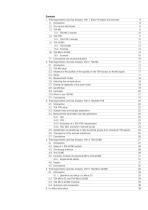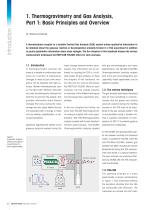
Catalog excerpts

Thermal Analysis Introductory Handbook Thermal Analysis in Practice Evolved Gas Analysis
Open the catalog to page 1
Selected Applications Thermal Analysis Disclaimer The selected application examples presented in this guide were conducted with the utmost care and in accordance with our present knowledge. METTLER TOLEDO does not assume responsibility for the safety or accuracy of experiments carried out using the methods or instruments described in this handbook. When chemicals, solvents and gases are used, the general safety rules and the instructions given by the manufacturer or the supplier must be observed. ® TM All names of commercial products can be registered trademarks, even if they are not...
Open the catalog to page 3
Preface A thermogravimetric analyzer (TGA) coupled on-line to an evolved gas analysis (EGA) system provides quantitative (mass loss) and qualitative (identification) information about gaseous reaction or decomposition products produced by a material during a TGA measurement. The thermogravimetric analyzer records the mass loss of a sample while the sample is exposed to a temperature program (dynamically) or to a specific temperature as a function of time (isothermally) in a controlled atmosphere. METTLER TOLEDO also supplies TGA/DSC instruments which simultaneously record the heat flow to...
Open the catalog to page 5
Contents 1. Thermogravimetry and Gas Analysis, Part 1: Basic Principles and Overview 1.1. Introduction 1.2. The various techniques 1.3. TGA-MS 1.3.1. TGA-MS: Example 1.4. TGA-FTIR 1.4.1. TGA-FTIR: Example 1.5. TGA-GC/MS 1.5.1. TGA-GC/MS 1.5.2. Example 1.6. TGA-Micro GC/MS 1.6.1. Example 1.7. Conclusions and recommendations 2. Thermogravimetry and Gas Analysis, Part 2: TGA-MS 2.1. Introduction 2.2. TGA-MS setup 2.3. Influence of the position of the capillary in the TGA-furnace on the MS signal 2.4. Gases 2.5. Measurement modes 2.6. Detecting low concentrations 2.7. Overlap of fragments of...
Open the catalog to page 7
1. Thermogravimetry and Gas Analysis, Part 1: Basic Principles and Overview Dr. Markus Schubnell A thermobalance coupled to a suitable Evolved Gas Analysis (EGA) system allows qualitative information to be obtained about the gaseous reaction or decomposition products formed in a TGA experiment in addition to purely quantitative information about mass changes. The five chapters of this handbook discuss the various measurement techniques that METTLER TOLEDO offers for such analyses. mass change however remain unan- with gas chromatography and mass swered. This information can be ob-...
Open the catalog to page 8
Figure 2. Mass spectrum of methane (CH4). The m/z 17 ion corresponds to the singly charged CH4 molecule containing a 13C atom. On the Earth, the two stable carbon isotopes 12C and 13C are present in a ratio of about 99 to 1. positively charged molecular ions and numerous fragment ions. The ions Mass spectrum of methane produced and their relative intensities depend on the energy of the electrons the mass spectrometer and is typically 70 eV. This voltage produces mainly singly charged ions. The ions then enter an alternating electromagnetic field, a so-called mass fil- Relative intensity...
Open the catalog to page 9
ganic molecules) is difficult because of protective film of paraffin, polyethylene cause different compounds often exhib- their fragmentation. On the other hand, it fragment ions with the same mass- the substances is not always easy be- TGA-MS is extremely useful for the de- to-charge ratio in their mass spectra tection of small molecules (for example Despite the protective coating, cobalt (for example, ammonia yields the frag- oxide is still formed. The content can further details, see the METTLER TOLEDO be determined by performing TGA-MS Evolved Gas Analysis Handbook [1]. measurements....
Open the catalog to page 10
Figure 6. TGA-FTIR measurement of an active pharmaceutical ingredient (API) that had been recrystallized in an unknown solvent. Figure 4 shows that a hydrogen equivalent of 321.5 nCb is needed (integration of the broad peak in the m/z 2 curve) for the reduction of 42.75 mg Co 3 O 4 . The MS cur ve in Figure 3 showed that a hydrogen equivalent of 13.28 nCb was needed to reduce the Co 3O 4 present in the coated cobalt powder. This evaluation gives a mass of 1.77 mg Co3O4 in the coated cobalt powder sample and corresponds to a Co3O4 content of 1.44%. 1.4. TGA-FTIR FTIR spectroscopy is based on...
Open the catalog to page 11
tify the solvent that had been used and To identify the solvent, the IR spec- of specific functional groups (e.g. of to determine how much of it was still trum of the gases evolved at a TGA alcohols or of aromatic compounds, Quite often, however, the identification etc.) in the reaction products is also more closely. Comparison of the important. For further details, see the spectrum with database spectra gave METTLER TOLEDO Evolved Gas Analy- good agreement with 2-methoxyethyl DTG curves show three main process- ether, MEE, (Figure 7). This was there- es: The small mass loss from room fore...
Open the catalog to page 12
Figure 10. The TGA and DTG curves and results of gas analysis using GC/MS of an unknown elastomer. The measurement was performed at a heating rate of 10 K/min and a flow rate of 30 mL/min nitrogen. In this particular case, it is best to determine the mass loss and hence the residual content of MEE in the product from the DTG curve as indicated in Figure 6. This yields an MEE content of about 4.1%. 1.5. TGA-GC/MS As previously mentioned, the interpretation of mass spectra or infrared spectra is more difficult when several unknown gaseous products are simultaneously released. In such cases,...
Open the catalog to page 13
Boiling point Only possible with TCD, adapted columns (e.g. MS5A and PPU) and Argon as carrier gas for MS5A column Hydrocarbons C1 to C3, light solvents (methanol, acetone), H2S, COS... Hydrocarbons C1 to C10, BTEX, small acids, furan... Only possible with adapted columns (e.g. PLOT-MS) Hydrocarbons C11 to C14, mercaptans, smaller phenols Molecules with boiling points >250 °C, high molecular weight additives, PAHs... TGA-Micro GC/MS Module A (MS5A column) Figure 12. Application range of TGA-Micro GC(/MS) and TGA-IST-GC/MS. The basic setup of a TGA-GC/MS sys- ment was to identify the...
Open the catalog to page 14All SRA Instruments catalogs and technical brochures
-
1088 Rotary Autosampler
2 Pages
-
1030S TOC
2 Pages
-
Aurora 1030W
4 Pages
-
Aurora 1030C
4 Pages
-
1080
8 Pages
-
SRA MicroGC Portfolio
6 Pages
-
Thermal Analysis Excellence
12 Pages
-
NEW LAB SOLUTIONS
2 Pages
-
SRA R990
4 Pages
-
AG-OFGAS-35
2 Pages
-
NG 7040
2 Pages















